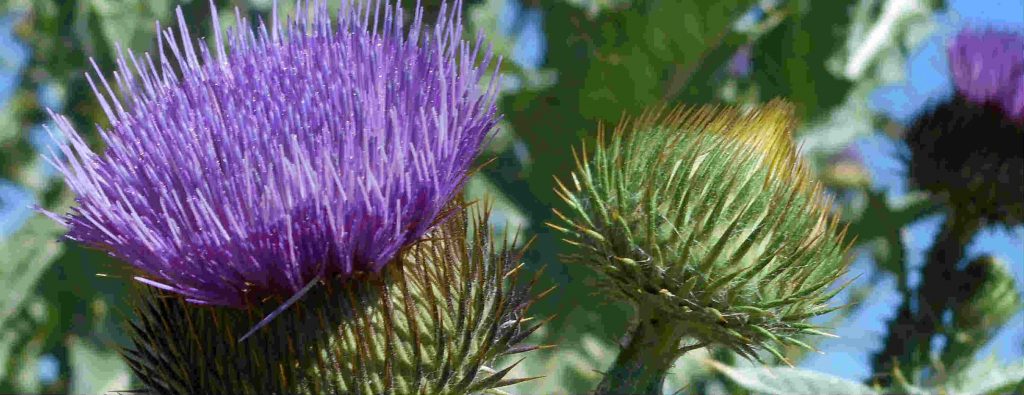Weeds are basically plants that are interfering with how we think our property should look. How a landowner manages their property can influence the number and type of weeds that they have. Over grazing pastures is one of the main reasons that weeds get a start on a property. There are multiple methods landowners can use to manage their weeds, but the first step is to positively identify the weed.
In simple terms a weed is just a plant out of place, however, managing some of these weeds is not a simple task. Noxious weeds are invasive non-native plants whose control is mandated by law. These plants pose a serious threat to native habitats, impact recreation and agriculture. They have displaced 130 native Colorado plants on 553,163 acres* in Colorado (*Colorado Dept of Agriculture).

Weed ID Service
The first step in controlling weeds is knowing what weeds you are dealing with.
You may submit weed samples to our office for identification. Review “Guidelines” and fill out “ID Form”. Call 303-678-6238 with questions.
Identification
- Guide to Poisonous Plants
- Colorado Weed Management Association (noxious weed ID)
- USDA NRCS Plants National Database (ID weeds and native plants)
Biological Weed Management (Insects)
Organic Weed Management
- Organic Weed Management
- ATTRA Weed Control Publications
- Cornell Organic Weed Management
- Capric Acid a Promising Next Generation Herbicide for use in Organic Systems
- Natural Herbicide for Landscape Weed Management
Chemical Weed Management
- Common Rangeland and Pasture Herbicides and Grazing Restrictions
- Grazing Restrictions by Herbicide
- Single Nozzle Sprayer Calibration
Colorado Department of Agriculture Pesticides Program
Contractors
(No endorsement implied)
Cultural Weed Management
– A Healthy Stand of Grasses is the Best Weed Suppression
Factsheets on Reseeding & Pasture Management
Factsheets
- Boulder County Noxious Weed Guide Mountain
- Boulder County Noxious Weed Guide Plains
- CSU Extension Factsheets (Scroll to Weed Factsheets)
- Range and Pasture Weed Management
- Weed Management after Forest Mitigation
- Weed Management for Small Rural Acreages
- Boulder County Nuisance Weed Guide
Local Sources for Weed Management
Mechanical Weed Management
Acetic Acid (“Vinegar”) Herbicides
Household, culinary vinegar is 5% acetic acid. While this concentration can provide some management, most commercial weed management products are 8-25% acetic acid. WHILE PERCEIVED AS LESS TOXIC HERBICIDES, THESE ACETIC ACID PRODUCTS HAVE HUMAN HEALTH HAZARDS THAT SHOULD BE TAKEN SERIOUSLY. WEAR APPROPRIATE PERSONAL PROTECTIVE EQUIPMENT (PPE) – EYE/FACE SHIELD, RESPIRATOR, CHEM GLOVES, CHEM APRON, ETC. Acetic acid concentrations over 11% can cause burns upon skin contact. Eye contact can result in severe burns and permanent corneal injury. The 25% acetic acid concentrations registered through EPA and the states for commercial use all have restricted entry intervals of 48 hours and list personal protection equipment to be used by the applicator.
Product Label Info
Colorado State University
Noxious Weeds & Invasive Species Management on Open Space
- Boulder County Noxious Weed Management Plan
- Colorado Noxious Weed Act (Scroll down to Title 35.Agriculture, Pest and Weed Control, Article 5.5 Colorado Noxious Weed Act
- Longmont and Boulder Valley Conservation District Noxious Weed Cost Share Program
Natural Resources
More Small Acreage Sites
Boulder County Supporting Links
Parks & Open Space – Agriculture
Boulder County Food – Agriculture Systems
State & Local Resources
Colorado State University Small Acreage Management
Boulder County Parks & Open Space
Longmont & Boulder Valley Conservation Districts
—————————————–
CDA – Colorado Department of Agriculture
CSFS – Colorado State Forest Service
CDNR – Colorado Division of Natural Resources
NRCS – Natural Resources Conservation Service



